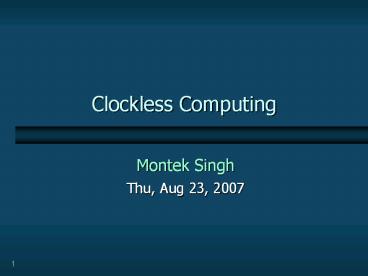Clockless%20Computing - PowerPoint PPT Presentation
Title:
Clockless%20Computing
Description:
dual-rail may be faster (if completion times vary widely) 2-phase vs. 4-phase ... rail needs fewer gates/wires/pins. design and verification effort. dual-rail, ... – PowerPoint PPT presentation
Number of Views:48
Avg rating:3.0/5.0
Title: Clockless%20Computing
1
Clockless Computing
- Montek Singh
- Thu, Aug 23, 2007
2
Preliminaries
- How is data represented in an asynchronous
system? - How is information exchanged? control
signaling (handshake styles)
3
Data Encoding Bundled Data
- Single-rail Bundled Datapath simplest approach
- widely used
- Features
- datapath 1 wire per bit (e.g. standard sync
blocks) - matched delay produces delayed done signal
- worst-case delay longer than slowest path
- Practical style can reuse sync components small
area - Fixed (worst-case) completion time
4
Bundled Data Completion Sensing
- Delay Matching
- either single worst-case delay
- or, fine-grain delay
- Speculative completion
- choose delay on the fly
- start with shortest delay increase as needed
5
Data Encoding Dual-Rail
- Dual-rail uses 2 wires per data bit
Each Dual-Rail Pair provides both data value and
validity
- provides robust data-dependent completion
- needs completion detectors
6
Dual-Rail Completion Sensing
- Dual-Rail Completion Detector
- combines dual-rail signals
- indicates when all bits are valid (or reset)
- C-element
- if all inputs1, output ? 1
- if all inputs0, output ? 0
- else, maintain output value
- OR together 2 rails per bit
- Merge results using a Müller C-element
7
Handshaking Styles 4-phase
- 4-Phase requires 4 events per handshake
- Level-sensitive ? simpler logic implementation
- Overhead of return-to-zero (RTZ or resetting)
- extra events which do no useful computation
8
Handshaking Styles 2-phase
- 2-Phase requires 2 events per handshake
- a.k.a. transition signaling
- Elegant no return-to-zero
- Slower logic implementation
- logic primitives are inherently level-sensitive,
not event-based (at least in CMOS)
9
Handshaking Styles Pulse Mode
- Pulse Mode combines benefits of 2-phase and
4-phase - use pulses to represent events
start next event
start event
Request
next event done
event done
Acknowledge
- No return-to-zero (like 2-phase)
- Level-based implementation (like 4-phase)
- Need a timing constraint on pulse width
10
Handshaking Styles Single-Track
- Single-Track combines req and ack onto single
wire! - one wire used for bidirectional communication
- sender raises, receiver lowers
- Efficient protocol no return-to-zero,
level-based - Need aggressive low-level design techniques
- much effort to ensure reliability, satisfy timing
constraints
11
Handshaking Data Representation
- Several combinations possible
- dual-rail 4-phase, single-rail 4-phase, dual-rail
2-phase, and single-rail 2-phase - Example dual-rail 4-phase
A
B
- dual-rail data functions as an implicit
request - 4-phase cycle between acknowledge and implicit
request
12
Other Data Representation Styles
- Level-Encoded Dual-Rail (LEDR)
- 2 wires per bit data and phase
- exactly one wire per bit changes value
- if new value is different, data wire changes
value - else phase wire change value
- M-of-N Codes
- N wires used for a data word
- M wires (M lt N) change value
- Values of N and M have impact on
- information transmitted, power consumed and logic
complexity - Knuth codes, Huffman codes,
13
Which to use?
- Depends on several performance parameters
- speed
- single-rail vs. dual-rail
- single-rail may be faster (if designed
aggressively) - dual-rail may be faster (if completion times vary
widely) - 2-phase vs. 4-phase
- 2-phase may be faster (if logic overhead is
small) - 4-phase may be faster (if overhead of
return-to-zero is small) - power consumption
- 2-phase typically has fewer gate transitions (?
lower power) - amount of logic used (gates/wires/pins ? chip
area) - single-rail needs fewer gates/wires/pins
- design and verification effort
- dual-rail, 1-of-N, M-of-N, Knuth codes
- delay-insensitive robust in the presence of
arbitrary delays - single-rail requires greater timing
verification effort
14
Homework 2 (due Thu Aug 30)
- Suppose you are given N wires
- Which M-of-N encoding (i.e. what M) encodes most
information? - Suppose you have to encode 4-bit values
- Which M-of-N encoding yields fewest wires?
- Suppose you can switch at most 2 wires
- Which M-of-N encoding yields fewest wires for
4-bit values?































